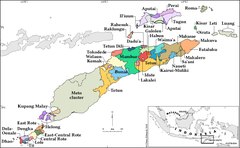Języki oirata-makasai
| Obszar |
Timor Wschodni, Indonezja (wyspa Kisar) |
|---|---|
| Klasyfikacja genetyczna |
języki transnowogwinejskie (?)
|
| Podział |
• język makasai |
| Kody rodziny językowej | |
| Glottolog | east2520 |
| Występowanie | |
 Języki wyspy Timor i okolic | |
| Ta strona zawiera symbole fonetyczne MAF. Bez właściwego wsparcia renderowania wyświetlane mogą być puste prostokąty lub inne symbole zamiast znaków Unicode. | |
Języki oirata-makasai, także wschodniotimorskie – grupa kilku języków papuaskich używanych przede wszystkim w Timorze Wschodnim. W piśmiennictwie lingwistycznym są omawiane wraz z papuaskimi językami wysp Alor i Pantar, z którymi tworzą rodzinę języków timor-alor-pantar[1][2]. Wszystkie te języki są często zaliczane do większej rodziny transnowogwinejskiej, obejmującej także ogromną liczbę języków z oddalonej geograficznie Nowej Gwinei[3][4] (wcześniej zostały sklasyfikowane w ramach języków zachodniopapuaskich[5]).
Język oirata jest używany na pobliskiej wyspie Kisar (w prowincji Moluki w Indonezji)[6]. Badania indonezyjskich językoznawców ujawniły, że języki fataluku i oirata są sobie szczególnie bliskie, przy uwzględnieniu ich związków z językiem makasai[7]. W taki oto sposób przedstawia się podział wewnętrzny grupy oirata-makasai.
- makasai (w tym etnolekt makalero)
- grupa oirata-fataluku
Według nowszej klasyfikacji makasai i makalero stanowią odrębne języki[8].
Prajęzyk
[edytuj | edytuj kod]Źródło: Ross 2005[9].
prawschodniotimorski oirata (dopełnienie) fataluku makasai 1lp *ani an-te (ani) ani ani 2lp *ai aa-te/ee-te[a] (ee) e ai 1eks *ini in-te (in) ini ini 1in *api ap-te (ap) afi fi 2mn *i ii-te (ii) i i
Uwagi
[edytuj | edytuj kod]- ↑ ee-te – forma grzecznościowa
Przypisy
[edytuj | edytuj kod]- ↑ Gary Holton i inni, The Historical Relations of the Papuan Languages of Alor and Pantar, „Oceanic Linguistics”, 51 (1), 2012, s. 86–122, DOI: 10.1353/ol.2012.0001, JSTOR: 23321848, hdl: 1887/18594 (ang.).
- ↑ Antoinette Schapper, Juliette Huber, Aone van Engelenhoven: The historical relation of the Papuan languages of Timor and Kisar. W: Harald Hammarström, Wilco van der Heuvel (red.): History, Contact and Classification of Papuan Languages. Port Moresby: Linguistic Society of Papua New Guinea, 2012, s. 194–242, seria: Language and Linguistics in Melanesia, Special Issue: On the History, Contact & Classification of Papuan Languages – Part I. (ang.).
- ↑ Holton i Klamer 2018 ↓, s. 578–579.
- ↑ Timothy Usher, West Bomberai [online], NewGuineaWorld [dostęp 2020-06-06] [zarchiwizowane z adresu 2020-02-29] (ang.).
- ↑ Donohue 2008 ↓, s. 43.
- ↑ Holton i Klamer 2018 ↓, s. 578
- ↑ Halus Mandala, Aron Meko Mbete, Inyo Yos Fernandez Ni Made Dhanawaty, Phonological Evolution of Oirata and its Genetic Relationship with Non-Austronesian Languages in Timor Leste, „e-Journal of Linguistics”, 5 (2), 2011, ISSN 2442-7586 [dostęp 2024-07-27] (ang.).
- ↑ Juliette Huber: Makalero and Makasae. W: Antoinette Schapper (red.): The Papuan Languages of Timor, Alor and Pantar: Sketch Grammars. T. 2. Berlin–Boston: De Gruyter, 2017, s. 267–351, seria: Pacific Linguistics 655. DOI: 10.1515/9781614519027-005. ISBN 978-1-61451-902-7. OCLC 1018123620. (ang.).
- ↑ Malcolm Ross: Pronouns as a preliminary diagnostic for grouping Papuan languages. W: Andrew Pawley, Robert Attenborough, Robin Hide, Jack Golson (red.): Papuan pasts: cultural, linguistic and biological histories of Papuan-speaking peoples. Canberra: Pacific Linguistics, Research School of Pacific and Asian Studies, Australian National University, 2005, s. 15–66, seria: Pacific Linguistics 572. ISBN 0-85883-562-2. OCLC 67292782. [dostęp 2022-09-20]. (ang.).
Bibliografia
[edytuj | edytuj kod]- Mark Donohue: Bound pronominals in the West Papuan languages. W: Claire Bowern, Bethwyn Evans, Luisa Miceli (red.): Morphology and Language History: In honour of Harold Koch. Amsterdam–Philadelphia: John Benjamins Publishing, 2008, s. 43–58, seria: Current Issues in Linguistic Theory 298. DOI: 10.1075/cilt.298.06don. ISBN 978-90-272-9096-0. OCLC 277090439. (ang.).
- Gary Holton, Marian Klamer: The Papuan languages of East Nusantara and the Bird’s Head. W: Bill Palmer (red.): The Languages and Linguistics of the New Guinea Area: A Comprehensive Guide. Berlin–Boston: Walter de Gruyter, 2018, s. 569–640, seria: The World of Linguistics 4. DOI: 10.1515/9783110295252-005. ISBN 978-3-11-028642-7. OCLC 1041880153. [dostęp 2022-10-25]. (ang.).
Text is available under the CC BY-SA 4.0 license; additional terms may apply.
Images, videos and audio are available under their respective licenses.
